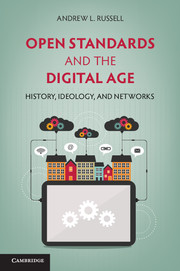Book contents
- Frontmatter
- Dedication
- Contents
- Tables and Figures
- Acknowledgments
- List of acronyms
- 1 Introduction
- 2 Ideological Origins of Open Standards I: Telegraph and Engineering Standards, 1860s–1900s
- 3 Ideological Origins of Open Standards II: American Standards, 1910s–1930s
- 4 Standardization and the Monopoly Bell System, 1880s–1930s
- 5 Critiques of Centralized Control, 1930s–1970s
- 6 International Standards for the Convergence of Computers and Communications, 1960s–1970s
- 7 Open Systems and the Limits of Democratic Design, 1970s–1980s
- 8 The Internet and the Advantages of Autocratic Design, 1970s–1990s
- 9 Conclusion
- Bibliography
- Index
- References
4 - Standardization and the Monopoly Bell System, 1880s–1930s
Published online by Cambridge University Press: 05 June 2014
- Frontmatter
- Dedication
- Contents
- Tables and Figures
- Acknowledgments
- List of acronyms
- 1 Introduction
- 2 Ideological Origins of Open Standards I: Telegraph and Engineering Standards, 1860s–1900s
- 3 Ideological Origins of Open Standards II: American Standards, 1910s–1930s
- 4 Standardization and the Monopoly Bell System, 1880s–1930s
- 5 Critiques of Centralized Control, 1930s–1970s
- 6 International Standards for the Convergence of Computers and Communications, 1960s–1970s
- 7 Open Systems and the Limits of Democratic Design, 1970s–1980s
- 8 The Internet and the Advantages of Autocratic Design, 1970s–1990s
- 9 Conclusion
- Bibliography
- Index
- References
Summary
I think that if we don’t consider a distinction in our use of the word standard and standardization we are very likely to get into trouble … outsiders will have reason to assert that what we are attempting to do is to muzzle all possible development. What we are actually trying to do by our standardization work is to develop the telephone art in the best way that we know how to develop it.
– Frank Jewett, Assistant Chief Engineer, Western Electric, 1915We have seen how organizations such as the American Standards Association (ASA) arose as creative responses to the status quo – that is, to the inadequacy of existing markets and hierarchies to provide effective mechanisms to coordinate technical standardization in American industry. The emergence of the “voluntary consensus” model of committee standardization, significant as it was, begs a related question: How did monopoly firms develop standards, and how did their standardization efforts fit within the collaborative, consensus-based model developed in the late nineteenth and early twentieth centuries within trade associations and engineering societies?
Conventional answers to these questions point to the power of the managerial hierarchies that exist within monopoly firms. In the conventional view, monopolies create standards through a hierarchical, closed, and proprietary process as part of a broader strategy to erect barriers to entry and maintain centralized control over a given market or markets. They capture the network effects that standardization generates. Monopolies, in this view, act in a monolithic and almost petulant manner: their goal is to reduce variety, stifle outside innovations, lock in users, and preserve their control.
- Type
- Chapter
- Information
- Open Standards and the Digital AgeHistory, Ideology, and Networks, pp. 95 - 130Publisher: Cambridge University PressPrint publication year: 2014



